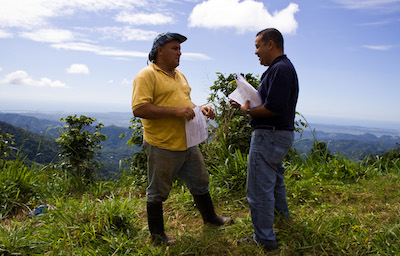Changes to the Agricultural Worker Protection Standard
Introduction to the Application Exclusion Zone
Application Types and AEZ distances
Changes to the Agricultural Worker Protection Standard
Updates made to the Agricultural Worker Protection Standard (WPS) in 2015 are meant to protect workers and other people from pesticide exposure. One new addition is the application exclusion zone (AEZ) in outdoor production. Outdoor production includes farms, vineyards, forests, and nurseries.
The AEZ is an additional requirement, separate from the restricted entry interval (REI) already required by pesticide labels. The AEZ requirements only apply during applications and the REI requirements are applicable after applications.
Introduction to the Application Exclusion Zone
The AEZ is an area surrounding pesticide application equipment that people should not enter during pesticide applications. Equipment can include aircraft, tractors, backpack sprayers, etc. Agricultural employers must keep workers and other people out of this zone within the boundaries of the agricultural establishment after the application begins.

The AEZ is measured as a horizontal straight line from the application. It moves with the equipment and surrounds the application equipment in all directions, like a halo. If the equipment moves, the AEZ moves as well.
The AEZ does not apply to indoor, enclosed space production. Applications in enclosed spaces have their own entry restrictions. See Chapter 3 of the HTC. Enclosed space production includes agricultural plants maintained in greenhouses, mushroom houses, hoop-houses, polyhouses and any indoor grow houses.
Application types and AEZ distances
The size of the AEZ varies depending on the application type. Use the table below to determine how far workers and other people must stay from the application.
| Application Type | AEZ |
|---|---|
|
100 feet in all directions |
| Spray from more than one foot off the ground (or planting medium) and with medium or larger droplet size | 25 feet in all directions |
| All other application types | No AEZ required |
Responsibilities for agricultural employers

Effective January 2, 2017, agricultural employers must not allow workers or other people to enter or be in the AEZ during an application within the boundaries of their establishment. This includes housing or other buildings in the AEZ within the boundaries of the property.
Responsibilities for handlers
Handlers cannot begin an application if anyone is inside the AEZ within the boundaries of the agricultural establishment. If anyone enters the AEZ during the application, on or off the establishment, handlers must suspend the application.
If people are in the AEZ within the boundaries of the establishment, the handler cannot resume an application until they move. If people are in the AEZ outside the boundaries of the establishment, the handler can only resume if the handler can ensure the pesticide will not contact those people.
A pesticide may not contact people directly or through drift.
Effective dates for AEZ requirements
If you are an agricultural employer, the AEZ requirement goes into effect January 2, 2017. Starting then, employers must keep all workers and people out of the AEZ on their agricultural property.
If you are a handler, you should work with the agricultural employer to help them comply with their requirement to keep workers and other people out of the AEZ on the property starting January 2, 2017. After January 2, 2018, handlers must suspend applications as soon as workers or other people enter the AEZ. This applies to areas on- or off-property. This requirement was delayed so handlers could receive training about the AEZ.
Learn more:
Application Exclusion Zone Fact Sheet
Application Exclusion Zone Infographic


